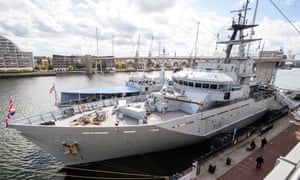Royal Navy aims to put laser 'death ray' on ships by 2020
At arms fair in London, Admiral Sir George Zambellas says navy plans to demonstrate a directed energy weapon at sea by end of decade

A Royal Navy vessel moored outside the ExCeL centre in London during the Defence and Security Equipment International exhibition. Photograph: Leon Neal/AFP/Getty Images
The Royal Navy hopes to develop a ship-mounted “death ray” laser cannon by 2020, the first sea lord, Admiral Sir George Zambellas, has announced at one of the world’s biggest arms fairs.
The US navy has been experimenting with a laser to take out drones and damage enemy ships. The UK, hoping to build on the American experience, is looking to build something less cumbersome, more efficient, requiring less manpower and much more destructive.
This year the Ministry of Defence said it had instructed its development arm, the Defence Science and Technology Laboratory (DSTL), to look at building a prototype. But Zambellas went much further when he addressed a group of senior navy personnel from around the world as well as arms company representatives in London. He said technological advances had the power to change how the navy operated.
One of those advances, he said, was novel, high-energy weapons. “Energy weapons don’t require conventional ammunition. With a cost-per-shot potentially measured in pence rather than pounds, they offer a route to address the spiralling costs of missile development and production, as well as reducing supply chain demands,” he said.
“With DSTL, the Royal Navy plans to demonstrate a directed energy weapon at sea by the end of the decade.”
The US navy demonstrated a laser cannon on one of its ships in the Gulf last year. The Ministry of Defence is looking to have a land-based cannon by 2017 and a ship-mounted one by 2020.
It is purely experimental at this stage, with no policy decision yet on whether to put it on planned type-26 frigates. It would have to be demonstrated that the laser cannon would be of more value that existing guns.
There were early experiments using lasers to try to blind enemy pilots or to disrupt the electronic systems of planes. But the new types of lasers being developed are intended to destroy, in particular enemy planes, and should be capable of dealing at high speed with multiple targets.
The navy is also looking at how to power the weapons. Zambellas said it was not just about launch platforms but power stations too.
”We are currently working with the DSTL to explore the role that electric flywheel technology, the kind used in Formula 1 racing, could play to generate and store the power required for high-energy weapons,” he said.
The four-day Defence and Security Equipment International fair, which is held every two years, opened on Tuesday at the ExCel in London. It is a showcase for defence companies.
According to the organisers it has attracted exhibitors from more than 50 countries, and an estimated 32,000 visitors are expected. The UK was the second largest defence exporter in the world in 2013.
As well as exhibitions showing new missiles, rifles and other weapons, there is a large section dealing with counter-terrorism equipment.
Human rights groups have been mounting protests outside. The Campaign Against Arms Trade published a poll saying 70% of UK adults opposed the promotion of military exports to human rights abusers and 60% did not believe that the UK should be promoting sales to countries that are not democracies.
Source: The Guardian, Uk.
No comments:
Post a Comment